Exploring the Okavango Delta was the absolute highlight of my recent travels in Botswana and Zambia, fusing excitement and relaxation together in just the right proportions.
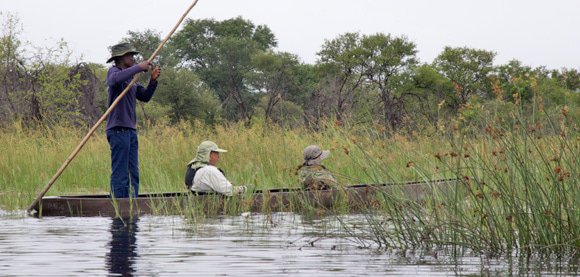
Most Memorable Moments in the Delta:
- standing up in my own mokoro and poling it across a placid lagoon
- hearing a lion roar into the still night, while sitting beside the campfire
- watching our local guides sing and dance by the fire and joining in
- being poled through the tranquil waterways in a dug-out mokoro canoe
- swimming amid the water lilies in a reed-lined channel near our camp
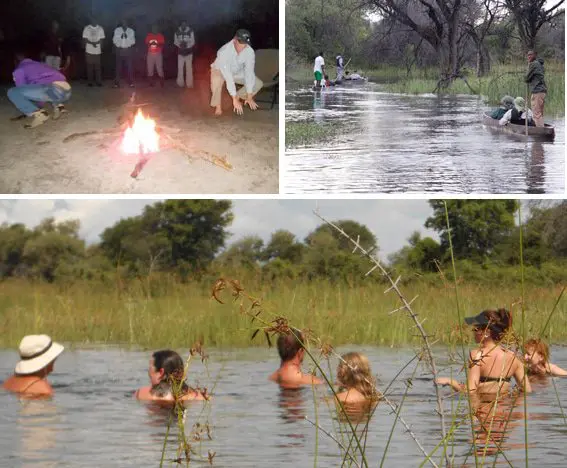
 Getting to Maun & the Okavango Delta
Getting to Maun & the Okavango Delta
Maun is the gateway town for travel to the Okavango Delta and Moremi Game Reserve, with Maun International Airport providing easy access to the natural gems of northern Botswana.
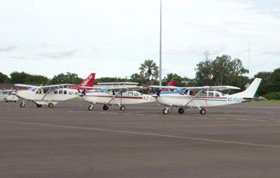 On my safari adventure we travelled from Victoria Falls in Zambia across the Zambezi River on the Kazungula Ferry and stayed overnight in Kasane, before driving on to Maun by road. This was a long and pretty uneventful day on the road, so I would definitely recommend flying to Maun instead. There are daily flights from regional hubs, including Victoria Falls, Johannesburg, Gabarone, Kasane and Windhoek.
On my safari adventure we travelled from Victoria Falls in Zambia across the Zambezi River on the Kazungula Ferry and stayed overnight in Kasane, before driving on to Maun by road. This was a long and pretty uneventful day on the road, so I would definitely recommend flying to Maun instead. There are daily flights from regional hubs, including Victoria Falls, Johannesburg, Gabarone, Kasane and Windhoek.
This busy airport lies within the town limits making it easy to catch a shuttle or taxi into Maun, but your best option is of course to arrange airport transfers with your tour operator or lodge.
Getting Into and Out of the Delta
Depending on where in the delta you are heading (its a big place), transport will be by boat, mokoro canoe, 4×4 vehicle and/or small plane. Many of the delta camps are only accessible by boat and plane, or a combination of plane and vehicle or plane and boat. For the sake of saving time and staying dry in the rainy season, travelling in an enclosed motorboat or airplane is a better way to go.
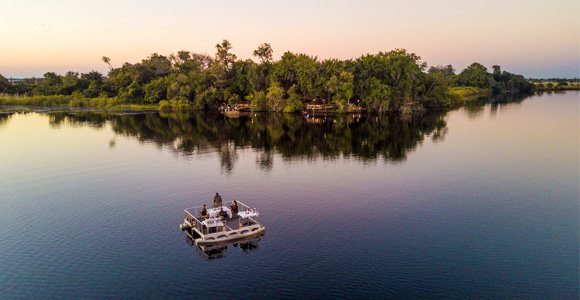 Xugana Island Lodge is a water-based camp that can only be reached by air and motorboat.
Xugana Island Lodge is a water-based camp that can only be reached by air and motorboat.
The best no muss, no fuss way to get into and out of the delta is to take a chartered flight. Numerous light aircraft flights carry passengers to and fro between Maun and the private lodges and camps in the Okavango Delta and Moremi Game Reserve. This is the ultimate means of travel, especially to avoid waterlogged roads in the rainy season, unless of course you’re travelling by motorboat.
The most noteworthy advantages of flying in and out are speed, comfort and perspective:
1. Speed Up – Save Time
Spend more time on safari and less time travelling to your camp via rough roads through dull and monotonous scenery. Flying saves precious time that can be better spent unwinding at your exclusive Okavango Delta lodge or enjoying memorable game viewing and adventure activities.
2. Comfort First – Go Over or Get Over It
On my budget trip we drove for three hours to arrive at a Mokoro Station on the fringes of the delta in a 4×4 safari vehicle. The first stretch of our drive was on a tarred road in fairly good condition, which went relatively smoothly. Driving in an open-sided 4×4 in the early morning hours was however a cold and windy affair, plus we had to breathe in the fumes of the vehicle in front of us. The second leg of the drive was on a muddy road through the bush – here we got splattered with mud and stuck in deep puddles from which we had to be towed. Suffice to say – I don’t recommend driving into the delta in the rainy season, if at any time of the year.

Arriving at the Mokoro Station there was a wait for the mekoros to arrive before we transferred our luggage into a speed boat and ourselves into the dug-out canoes. This was a marvellous way to enter the delta proper. I thoroughly enjoyed reaching the bush camp by gliding over the peaceful channels, despite the drizzle that welcomed us. This mokoro transfer only took about 20 minutes, bringing us into the mere outskirts of the delta, as opposed to the untamed depths.
Flying into the heart of the Okavango Delta is by far the most convenient and simplest option. If budget was less of a constraint I would rather have flown, any day.
3. Gain Aerial Perspective – Bird’s Eye View First
Flying into the Delta provides a enlightening introduction to this massive wetland system – putting the delta into perspective upfront. On my Delta Safari I only flew over the watery spectacle after spending time in it. I think that seeing the delta stretch out endlessly below you, before experiencing it on the ground, enables you to truly appreciate the magnitude of this wilderness area while you’re there. The flight is no less exciting than the overland mission, which is if you even consider getting stuck and covered in mud an adventure!
Just Air Charter It
One of the busiest airports in Africa, the Maun International Airport isn’t abuzz with international air traffic, but it sure does swarm with chartered flights.
 The baking tarmac is lined with single and twin-engine aircraft that transfer visitors to the private airstrips of remote camps in the Okavango Delta, as well as in Chobe, the Linyanti Concessions, Savuti, Moremi and more. It is more cost effective to pre-book flights between camps and into the delta, which is also a good idea in terms of seat availability. Unless you are booking an entire plane or travelling in a group, availability is on a per seat basis.
The baking tarmac is lined with single and twin-engine aircraft that transfer visitors to the private airstrips of remote camps in the Okavango Delta, as well as in Chobe, the Linyanti Concessions, Savuti, Moremi and more. It is more cost effective to pre-book flights between camps and into the delta, which is also a good idea in terms of seat availability. Unless you are booking an entire plane or travelling in a group, availability is on a per seat basis.
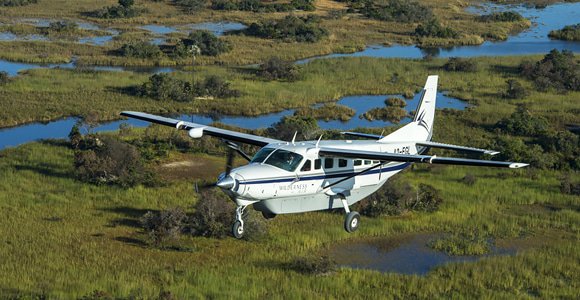 Wilderness Air flies to all the Wilderness Safaris properties, including Mombo Camp.
Wilderness Air flies to all the Wilderness Safaris properties, including Mombo Camp.
Planning the itinerary in advance or travelling with a reputable safari operator will save time and money on individual flights.
Many of the private lodges and luxury camps have their own charter companies and airstrips, some of which are shared with neighbouring camps. Once you’ve touched down in the middle of the bush, your lodge collects you and transfers you by boat or 4×4 game vehicle. The airstrip to lodge transfer usually gives you a chance to spot some game before you even arrive.
If you choose a fly-in safari (which you should), remember to check luggage restrictions with your tour operator. Many of the small planes only carry a limited amount of baggage per person (about 20kg or 44 pounds).
Flying Over the Delta for Fun
Taking scenic flights over the Okavango Delta is a hugely popular activity in Maun, particularly for those who are not on fly-in safaris. If you are not flying into and out of the delta – taking a scenic flight is a must!
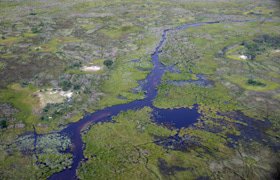
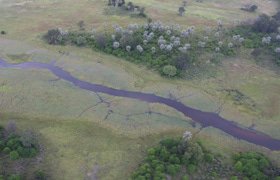
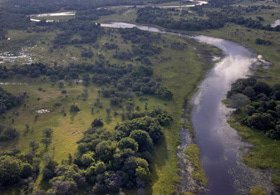

My scenic flight was a real adventure in a little four-seater plane. Arriving at the deserted-looking airport in Maun we handed our vouchers over, flashed our passports and walked through a check-point to the run-down departures “lounge”. Four of us bundled nervously into a small fixed-wing plane, queued up amongst the many variations lined-up on the tarmac. Taking off smoothly on our all-women flight, piloted by a young woman, we couldn’t help but think of Amelia Earhart with a smile.
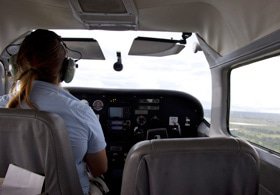
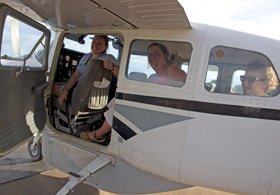
For the next 45 minutes or so we remained transfixed on the landscapes stretching out endlessly below us. From above, the Okavango Delta looked like a tangle of glistening ribbons running through the lush patches of vegetation surrounding the waterways. Noses and cameras pressed to the glass we spotted elephants, hippos, buffalos, giraffes and impalas grazing, wallowing and roaming around. The clouds were also an incredible sight and we were treated to a bright rainbow arched over the Eden-like scene beneath us.

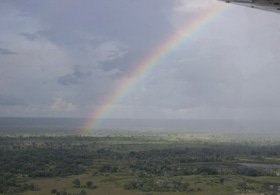
The most arresting aspect of the scenic flight was being able to comprehend the sheer scale of the Okavango Delta and the wilderness surrounding it!
A Bit About the Okavango Delta
Africa’s largest oasis, the Okavango Delta spreads out over some 15,000km² of northern Botswana. This is the biggest inland delta in the world and one of the last pristine wild places left on earth.
The delta is fed by the Okavango River which flows from the Angolan Highlands through Namibia and into Botswana, where it fans out into the Kalahari Desert. The Okavango Delta is all that remains of the once vast super lake, Lake Makgadikgadi. The course of the Okavango River is shaped by two faults channelling the Panhandle into the maze of lagoons, channels and reedbeds where life abounds. The delta has two main outlets – the Boteti River to Makgadikgadi in the east and one to Lake Ngami in the west.
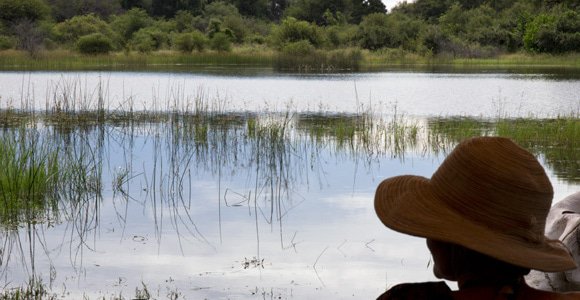
The lower reaches of the delta are where the reedbeds give way to seasonal floodplains, supporting the greatest variety and number of wildlife. The delta is home to the rare sitatunga antelopes, plenty of hippos, crocodiles and larger mammals such as lions, elephants and rhinos. The delta is inhabited by countless fascinating insects and small creatures, from dragonflies and spiders to bees, beetles and frogs. The wetlands are also a birding paradise hosting eagles, owls, skimmers, geese and many others.
To find out more about the Okavango Delta or start planning your own Botswana safari – simply get in touch.

 Getting to Maun & the Okavango Delta
Getting to Maun & the Okavango Delta